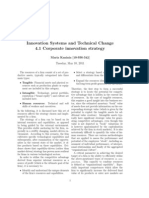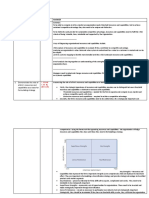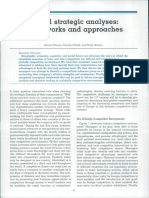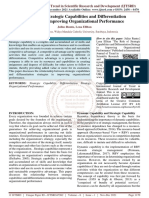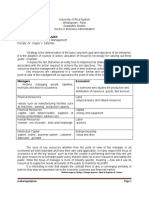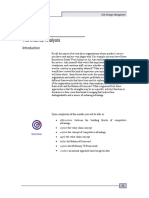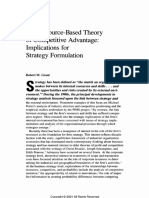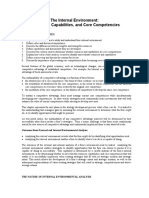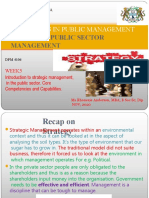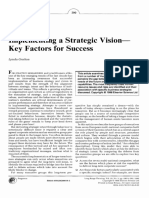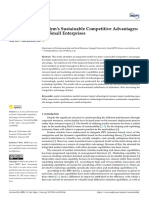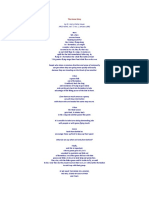See discussions, stats, and author profiles for this publication at: https://www.researchgate.net/publication/280246836
resource-based view
Chapter
· January 2014
DOI: 10.1002/9781118785317.weom120134
CITATIONS
2
READS
3,857
1 author:Some of the authors of this publication are also working on these related projects:
Wiley Encyclopedia of Management - Vol 12 Strategic Management
View projectindividual research
View projectJohn McGeeThe University of Warwick
137
PUBLICATIONS
1,784
CITATIONS
SEE PROFILE
All content following this page was uploaded by John McGee on 11 June 2018.
The user has requested enhancement of the downloaded file.

resource-based view
John McGee
T
HE
R
ESOURCE-BASED
V
IEW IN
T
HEORY
Economists see the rm as a bundle of produc-tive resources where resources are dened asinputs into the rm’s operations so as to producegoods and services. In this view, resources aregenericandspeciccategoriesarenotsuggested.However, typical examples include patents,capital equipment, and skilled and unskilledhuman resources. Strategists go further anddistinguish capabilities from resources. A capa-bility is the ability to perform a task or activitythat involves complex patterns of coordinationand cooperation between people and otherresources. Capabilities would include researchand development expertise, customer service,and high-quality manufacturing. Skills, bycontrast, are more specic relating to narrowlydened activities such as typing, machinemaintenance, and book-keeping.Strategists are interested in those resourcesand capabilities that can earn rents (a surplusof revenue over cost). These collectively areknown as
strategic assets
or
core competences
and are a subset of, but distinct from, thoseother resources and capabilities that do notdistinctively support the competitive advantage.The strategic task for the rm is to sustainthese rent streams over time by creating andprotecting the competitive advantage and thestrategic assets that together underpin them.The inherent value of the strategic assets forthe rm depends on the ways in which the rmcombines, coordinates, and deploys these assetsin concert the with other rm-specic and moregeneric resources and capabilities.The internal economy of the rm can be seenas sets of discrete activities (e.g., a product line),each of which leads to market positions andeach of which is supported by asset of resourcesand capabilities.
Similar
activities (e.g., theFord Mondeo and Ford Focus product lines)share some common strategic assets and somecommon generic assets. This sharing can leadto economies of scale (if different componentsshare the same production line), to economiesof scope (where products might go throughcommon distribution channels), and experienceeffects.
Complementary
activities require dissim-ilar sets of strategic assets, which would thenrequire degrees of coordination (e.g., marketingactivities and production activities). The skillsof coordination and internal cooperation are, infact, high-level capabilities with considerablestrategic signicance.In the real world of uncertainty and imperfectinformation, the rm may have (and usuallydoes have) considerable problems in knowingwhich particular congurations of its strategicassets will maximize prots. Managers do nothave perfect knowledge of future states of theworld, of alternative actions that could be taken,nor of the payoffs from adopting various alter-natives. Moreover, the way a manager choosesto allocate resources will be a function of pastpersonal experience, the rm’s experience,values, biases, and personality. Accordingly,even if two managers were given identicalbundles of resources, they would use them indifferent ways. The result is that a rm’s setof resources and capabilities will diverge fromthose of its competitors over time. Managersin competing rms in the same markets donot face the same sets of choices – rather theyhave different menus with different choices.The future, as rms see it, is to a greater orlesser degree uncertain and unknowable andtheir capacities for addressing the unknow-able are diverse. Furthermore, no amount of information gathering can resolve this funda-mental uncertainty of what the future will hold.Thus, strategy making is a long way from thesimplistic assumptions of the economic model.Strategies tend to be unique and idiosyncratic,and simplistic theories for success are usually“magic theories,” that is, theories that explaineverything but predict nothing. Nor are theresimple rules for riches, that is, there are noautomatic rules that provide benets in thelong run.This means that strategic management is notcaptured in the form of a strategic theory of the rm in a way that enables equations to beidentied, data collected, analyzed, and simplerules be inferred. Strategic management is muchmore eclectic and diverse. Contexts external andinternal to the rm are highly idiosyncratic.This places a premium on the ability to diagnose
Wiley Encyclopedia of Management
, edited by Professor Sir Cary L Cooper.Copyright © 2014 John Wiley & Sons, Ltd.
2 resource-based view
CapabilitiesResourcesPositionaladvantageSuperiorvalue tocustomersSuperiorreturnsStakeholdervalueInvestmentprogramsCorecompetencesFinancialcapacity
Figure 1
Competitive advantage and core competence.
situations and formulate options. The specicroutes to high performance are many and variedand not readily susceptible to simple general-izations. This goes some way to explaining whythe resource-based view (RBV) is widely seenas lacking specicity and denable concepts,and having no traceable connection to realperformance improvements.
T
HE
L
ANGUAGE OF THE
RBV: W
HAT
I
S
C
ORE
C
OMPETENCE?
We introduce the RBV with Figure 1. The topline of the diagram shows how the rm’s invest-ment programs are directed toward the creationand development of resources and capabilities,and that these underpin the positional advantagefrom which superior value can be delivered tocustomers. The bottom line shows the valueand nancial consequences in terms of thecapacity of the rm to nance its investmentprograms. The RBV focuses on the resourcesand capabilities of the rm, asserting that it isthe distinctiveness of these that enables sustain-able positional advantages to be constructed.The added element in this diagram is the pres-ence of core competences as representing thoseresources and capabilities that are distinctive tothe rm. As a result, competitive advantage isseen as the joint product of core competencesand positional advantage. What many writersobserve is that imperfections in the resourceand capability markets are more in number andlarger in size than those in product markets.This places the burden on rms to pay attentionto the underpinnings of competitive advantagein resource and capability terms. What manywriters have also observed is that markets arechangeable and even volatile, whereas it is quitedifcult to get rms to change their internalcultures and processes quickly enough to keeppace with market changes.Here we follow Grant’s (1991, 2011) lead inusing “resources” to describe inputs that can,in general, be purchased on open markets andcustomized for use by the purchasers. Thus,production capacity might be generally avail-able but will be congured for specic use byeach purchaser. The activities of individualpurchasers may lead to imperfections in supplymarkets. For example, a company may seekto monopolize certain raw materials throughacquisition or maybe through offering long-term supply contracts. However, on their own,few resources are immediately productive. Bycontrast, the “capabilities” described here arerm specic. They are developed internallyagainst the specic needs and ambitions of eachcompany. They often depend on tacit knowl-edge, are path dependent in that they emergeand develop over time, and are not in the formof assets that can be traded. These resources andcapabilities have individual characteristics, but alargepartoftheirvalue-in-usetoarmisrelatedto their conguration and their coordination.Table 1 compares typical resources and typicalcapabilities. The distinctiveness of the rm’sspecic set of resources and capabilities is afunction of which resources to acquire and whatcapabilities to develop (the
conguration
issue),the way in which each of these is developed(the
rm-specicity
issue), and the way in which
resource-based view 3
Table 1
Resources and capabilities.
Resources Capabilities
Distribution coverage Specialized knowledgeFinancial capacity Customer service orientationShared expertise with related businesses Design expertiseLow-cost manufacturing and distribution systems Application experienceProduction capacity Trade relationshipsOwnership of raw material sources Ability to utilize relevant technologiesLong-term supply contracts Systems design capabilityFast, exible response capability
they are internally managed to create positionaladvantage (the
coordination
issue).
P
RAHALAD AND
H
AMEL ON
C
ORE
C
OMPETENCE
The language of assets, resources, and capa-bilities can be confusing. The Grant (2011)distinction between resources and capabilities isan easy distinction as any to maintain. However,it is laborious to keep referring to strategicresources and capabilities as those that system-atically and uniquely underpin the competitiveadvantage relative to those other resources andcapabilities that do not. Thus, it is attractiveto refer to these as
CORE COMPETENCES
, thelanguage popularized by Prahalad and Hamel(1990) in the
Harvard Business Review
. Theyprovide an unusual metaphor:
The diversied corporation is a large tree. Thetrunk and the major limbs are core products, thesmaller branches are business units; the leaves,owers, and fruit are end products. The rootsystem that provides nourishment, sustenance,and stability is the core competence. You can missthe strength of competitors by looking only attheir end products, in the same way you miss thestrength of a tree if you look only at its leaves
…
Core competences are the collective learningin the organization, especially how to coordinatediverse production skills and integrate multiplestreams of technologies.
BCG
AND
C
APABILITIES-BASED
C
OMPETITION
Prahalad and Hamel’s approach is to denecore competence as the combination of individual technologies and production skillsthat underlie a company’s product lines. Sony’score competence in miniaturization allows itto make everything from the Sony Walkmanto video cameras and digital cameras. Honda’score competence in engines and powertrainsallows it compete from lawnmowers to racingcars. However, this latter example shows adifculty in their approach in that Honda’sdealer network would be invisible – becauseof the focus on competences that lead directlyto products. A development of their idea iscontained in a Boston Consulting Group paperin 1992 on “capabilities-based” competition.This contained four basic principles:1. The building blocks of strategy are notproducts and markets but business proce-sses.2. Competitive success depends on trans-forming these key processes into strategiccapabilities that consistently provide supe-rior value to the customer.3. Companies create these capabilities bymaking strategic investments in a supportinfrastructure that links together andtranscends traditional strategic businessunits.4. Because capabilities necessarily cross func-tions, the champion of a capabilities-basedstrategy is the chief executive ofcer.This approach has the real merit of focusingon business processes as the integrative gluethat binds together the various lower levelingredients and on the investments that arerequired to make this effective. Unfortunately,







